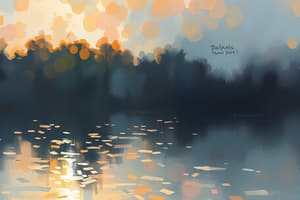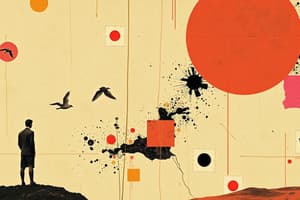Podcast
Questions and Answers
A ______ is an area enclosed by a line or lines.
A ______ is an area enclosed by a line or lines.
shape
Yellow, Red, and Blue are the ______ colors.
Yellow, Red, and Blue are the ______ colors.
primary
Green, Orange, and Violet (Purple) are the ______ colors.
Green, Orange, and Violet (Purple) are the ______ colors.
secondary
[Blank] is the aspect of things caused by differing qualities of light being reflected or emitted by them.
[Blank] is the aspect of things caused by differing qualities of light being reflected or emitted by them.
Hue, Value, and Saturation are the three properties of ______.
Hue, Value, and Saturation are the three properties of ______.
A color wheel diagram showing complementary colors, such as red and green, are ______ across from each other.
A color wheel diagram showing complementary colors, such as red and green, are ______ across from each other.
A color wheel diagram showing monochromatic schemes, use variations of a single ______.
A color wheel diagram showing monochromatic schemes, use variations of a single ______.
Red, orange, and yellow are considered ______ colors.
Red, orange, and yellow are considered ______ colors.
Green, blue, and violet are considered ______ colors
Green, blue, and violet are considered ______ colors
[Blank] refers to distances or areas around, between, or within components of a piece.
[Blank] refers to distances or areas around, between, or within components of a piece.
______ refers to a part enclosed in a shape.
______ refers to a part enclosed in a shape.
______ is the element that appeals to our sense of feel on things.
______ is the element that appeals to our sense of feel on things.
______ is the three-dimensionality of an object.
______ is the three-dimensionality of an object.
______ pertains to the lightness or darkness of a color in a given artwork.
______ pertains to the lightness or darkness of a color in a given artwork.
______ refers to the repetition of certain elements to produce a pattern.
______ refers to the repetition of certain elements to produce a pattern.
A continuous mark made on a surface is a ______.
A continuous mark made on a surface is a ______.
Lines can be described by their form and their ______.
Lines can be described by their form and their ______.
A horizontal line usually represents serenity and perfect ______.
A horizontal line usually represents serenity and perfect ______.
Strength and perfect stability is represented by a ______ line.
Strength and perfect stability is represented by a ______ line.
Action can be represented by a ______ line.
Action can be represented by a ______ line.
______ is the illusion of motion in a painting, sculpture, or design.
______ is the illusion of motion in a painting, sculpture, or design.
______ refers to the even distribution of positions of elements in an artwork.
______ refers to the even distribution of positions of elements in an artwork.
______ refers to the relationships of the size of objects in a body of work.
______ refers to the relationships of the size of objects in a body of work.
Visual ______ is achieved through arranging components to create stability.
Visual ______ is achieved through arranging components to create stability.
A color wheel is an arrangement of primary, secondary, and ______ colors.
A color wheel is an arrangement of primary, secondary, and ______ colors.
Red, Blue, and Yellow are ______ colors.
Red, Blue, and Yellow are ______ colors.
Violet, Green, and Orange are ______ colors.
Violet, Green, and Orange are ______ colors.
Red-Orange, Yellow-Green, and Blue-Violet are ______ colors.
Red-Orange, Yellow-Green, and Blue-Violet are ______ colors.
Colors that are next to each other on the color wheel are called ______ colors.
Colors that are next to each other on the color wheel are called ______ colors.
______ shows how stronger each element of art is in relation to one another.
______ shows how stronger each element of art is in relation to one another.
______ refers to the diversity or different elements used in an artwork to make it more interesting.
______ refers to the diversity or different elements used in an artwork to make it more interesting.
______ refers to the greater impact or highlight given to a certain element in an artwork.
______ refers to the greater impact or highlight given to a certain element in an artwork.
______ is about the arrangement of the related elements that makes an artwork to be viewed as a whole.
______ is about the arrangement of the related elements that makes an artwork to be viewed as a whole.
Flashcards
Shape
Shape
An area enclosed by a line or lines.
Geometric Shapes
Geometric Shapes
Shapes based on geometric figures like circles, squares, and triangles.
Hue
Hue
The name of a color, determined by its wavelength of light.
Color Wheel
Color Wheel
Signup and view all the flashcards
Saturation
Saturation
Signup and view all the flashcards
Complementary Colors
Complementary Colors
Signup and view all the flashcards
Monochromatic Colors
Monochromatic Colors
Signup and view all the flashcards
Warm Colors
Warm Colors
Signup and view all the flashcards
Cool Colors
Cool Colors
Signup and view all the flashcards
Space in Art
Space in Art
Signup and view all the flashcards
Positive Space
Positive Space
Signup and view all the flashcards
Negative Space
Negative Space
Signup and view all the flashcards
Texture
Texture
Signup and view all the flashcards
Form
Form
Signup and view all the flashcards
Value
Value
Signup and view all the flashcards
Line
Line
Signup and view all the flashcards
Horizontal Line
Horizontal Line
Signup and view all the flashcards
Vertical Line
Vertical Line
Signup and view all the flashcards
Diagonal Line
Diagonal Line
Signup and view all the flashcards
Curved Line
Curved Line
Signup and view all the flashcards
Rhythm
Rhythm
Signup and view all the flashcards
Movement
Movement
Signup and view all the flashcards
Balance
Balance
Signup and view all the flashcards
Proportion
Proportion
Signup and view all the flashcards
Elements in Art
Elements in Art
Signup and view all the flashcards
Contrast
Contrast
Signup and view all the flashcards
Variety
Variety
Signup and view all the flashcards
Emphasis
Emphasis
Signup and view all the flashcards
Harmony
Harmony
Signup and view all the flashcards
Primary Colors
Primary Colors
Signup and view all the flashcards
Secondary Colors
Secondary Colors
Signup and view all the flashcards
Tertiary Colors
Tertiary Colors
Signup and view all the flashcards
Analogous Colors
Analogous Colors
Signup and view all the flashcards
Color Relationships
Color Relationships
Signup and view all the flashcards
Study Notes
Elements of Art
- Shape is an area enclosed by a line or lines
- Types of Shapes
- Geometric Shapes
- Organic Shapes
- Positive Shapes
- Negative Shapes
- Static Shapes
- Dynamic Shapes
- Types of Shapes
Properties of Color
- Color is the aspect of things caused by differing qualities of light being reflected or emitted by them
- Colors we see in nature are reflections of light on the surfaces around us
- Three Properties of Color
- Hue
- Value
- Saturation
Forms of Space
- Positive- refers to a part which is enclosed in a shape
- Negative- the opposite part which the shape is enclosing
Texture
- Texture is the element that appeals to our sense of feel on things- rough or smooth, bumpy or slippery. It is the character of the surface of an artwork
Form
- Form is the three-dimensionality of an object. It has dimensions of height, width, and length
Value
- Value pertains to the lightness or darkness of a color in a given artwork
- Tint
- Shade
Studying That Suits You
Use AI to generate personalized quizzes and flashcards to suit your learning preferences.




